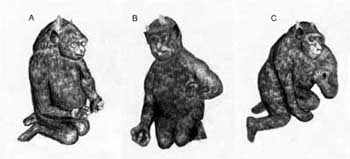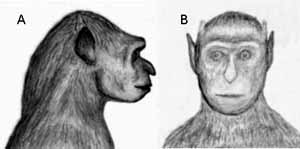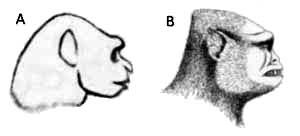Published in Natural and Technical Sciences (Estestvennye i Tekhnicheskie Nauki, ISSN 1684-2626) 2002, Iss.3, pp.38-42 in Russian. Translation by the author.
Reconstruction of alamas head (external appearance)
by
Dr. Michael S. Trachtengerts, Ph.D.
Moscow, Russia
In my previous publication [1] I presented three images of an unknown primate, that was photographed by A.Tishkov in Himalayas near to China-Nepal border. The basic attention in it was paid to the method which was used to reveal the animal figure from background in the magnified snapshots. The animal was described in detail as visible, but no aspects of its kind were discussed. In [1] I offered to name the animal found as alamas.
Now I attempt to reconstruct the head of the alamas specimen and compare it with what is available in the literature.
1. The basic images
Images of alamas were given in [1] in three different poses that the animal undertook in reply to movements of the observer in front of it. Fig.1 shows improved pictures of the poses that were received from the draft images [1]. Manual smoothing of granularity and artistic construction of three-dimensional forms of the body were applied as a first step to the analysis. The slide #1 is the source for frame A (alamas was not afraid yet when A.Tishkov arose for the first time); #2 - for frame B (alamas looked attentively at observer); and #3 - for frame C (it got ready to run away) accordingly.
 |
| Fig. 1 - The shaped pictures of alamas in photographed poses. |
2. Reconstruction of the alamas head
These images show various positions of members of the animal body that allows to carry out some geometrical transformations to turn them into a standard view. In particular, for head they are frontal and lateral views. As an example the plan to draw the head lateral outline is given in comprehensive Fig.2.
Contours A and B produce in C superior views of the alamas head from the poses Fig.1 A and B, moved to the common vertical axis in the top part of the head.
| Fig. 2 - The schema for constructions of the alamas head outlines. |
 |
The locations of the eyes and other characteristic points on the face help to estimate angles of the head top-down projections. After some circles were depicted with the centre on the chosen axis to their crossings with horizontal line (the projection of a vertical surface), we receive a set of basic points to finish the contour - Fig.2D. Choice of a place for the axis is necessary for geometrical constructions only and does not effects the final result if provided that the axis shows the same point on the head figures.
The detailed figure of alamas head in Fig.3A was developed with outline proportions Fig.2D and visible peculiarities of the faces that the artist finds in all poses in Fig.1. So, all images show advanced brow ridges; frames A and C - very sloping forehead, the oblique chin on massive lower jaw, and the form of back part of the neck; frame B - wide cutting of the mouth; frames A and B - pointed ahead and somewhat down tip of the nose; and all frames - large pointed up ears; and so on.
The similar procedure has resulted in the reconstruction of the frontal view of alamas head in Fig.3A. All frames were also used to portray the details of the face as in previous case.
 |
| Fig. 3 - Reconstruction of the alamas head. |
The beams of lighter hair seen on the head above the ears are left in the figure also. It may be noted that in case of the frontal view the face prognathism is concealed and the creature gets more "human" shape.
3. Comparison of the reconstruction with data by V.Khakhlov.
A.Tishkov wasn't the unique person who saw hominoids in that area of Himalayas. Chinese participants of the expedition talked him that some years before members of another expedition saw a similar creature, but presented no communication.
From other data the greatest interest for comparison with alamas presents information by zoologist Vitaliy Khakhlov [2]. He received it in study of Eastern Kazakhstan fauna at the beginning of the last century (1907 - 1917) near lake Zaisan on Russian-Chinese (now China-Kazakhstan) border.
When applying to the description of the "wild man", "ksy-gyik" in Kazakh, by V.Khakhlov it is necessary to note that he did not see the creatures in person. He made generalized pictures of it after scrupulous interrogations of two eyewitnesses - native inhabitants.
The first of them took part in capture of ksy-gyik when it came to à herd of horses. It was seized with help of a lasso. Then the creature (it was of a male) was oserved and the horsemen were convinced that it not a thief of horses. The "wild man" was let free. The second saw captured "wild woman" which was fastened to a chain. The encounterings took place at 250 km one from other. A.Tishkov saw alamas at distance 1500 - 2000 km from the places. On conversations with the eyewitnesses V.Khakhlov had made schematic sketches of head, hand, and foot of a "wild man", its appearance during sleep, view in full uprise, and probable form of the skull also. These figures, as Khakhlov had confessed, show in whole correctly the shape of ksy-gyik, but in some details did not satisfy the narrators. They, being completely uneducated, could not distinctly explain, what exactly did not suit them.
First of all let's set features that are close in alamas and the creature described by Khakhlov.
They were almost the same high. Alamas was about 140 cm as A.Tishkov estimated by measurement of visible boulder. Ksy-gyik according to the eyewitnesses was as average man, i.e. 10 - 15 cm higher, what is unsignificant in view of creature age uncertainties. In both cases the hair covered all body. They had similar type of heads with outstanding brow ridges and forehead in the usual sense was absent. They both practiced to stay and sit on knees that is unique feature and till now is not met among primates, except for the human of course. V.Khakhlov had noted the pecularity in a ksy-gyik positon to sleep and in large callouses on its knees. Alamas was on its knees in all three images presented.
I think that said above gives enough reasons to compare the revealed features of alamas head to those of ksy-gyik discribed verbally and in pictures by eyewitnesses and Khakhlov. The relevant citations from Khakhlov's communication are put in inverted commas and featured with italics.
Fig. 4 shows the increased contour of alamas head (A) from Fig.2D and picture by V.Khakhlov (B) turned for convenience of comparison.
 |
|
Fig. 4 - Comparison of head forms of alamas reconstruction (A) and ksy-gyik (B). |
General characteristics.
The head of ksy-gyik is kept on very strong neck - "neck of the "wild man" is very thick ("as a bull have") and the strong muscles are visible on the nape". On Fig.4 alamas has this feature more expressed than ksy-gyik has, though part of this thickening can be referred to the hair that probably is falling down from head on neck. "On a question, what the head reminds - water-melon, melon, or human skull, but extended back and upwards, - the eyewitness was at loss what to answer. After long efforts and demonstrations on his own head it seems possible to seize the essence of the question and to draw a figure on ground near to oven; it was found also out that the cranium was elongated a little, but the head in whole seemed elongated because of outstanding jawbones and tipped top.
I feel need to understand the tipped head. During conversation the eyewitness told: "it is the same as a dog has". It, I may confess, was for me very unexpected. Someone was sent now for a dog to aul (native village). The dog sat on the ground and story-teller strongly lowered its head to neck. I have understood what the eyewitness meant. The head of the dog really appeared pointed on top, and neck muscles on each side protruded as tumors."
The elongation characteristics of ksy-gyik head, that were given by the witness to prognathous jaws, obviously suitable to alamas also. As to a head top and part of the head below, on my view, dogs does not show such sharp form, as the ksy-gyik picture presents. Its nape muscle always curved up instead of forming a niche. It is impossible to judge about sharp alamas nape because on all snapshots its face is turned at different angles to the observer. The shape of alamas nape on Fig.4A was obtained by extrapolation upwards of visible back line of the neck.
The story-teller said also about forehead: "It has forehead, but it is hardly notable, because his forehead is very sloping and is covered by a calloused skin above brow arches, and behind it is the hair". For explanation he again pointed at forehead of the dog. The main distinction in that part of head shown in Fig.4 is: ksy-gyik has a little bit convex forehead, and alamas - the concave one.
"About hair on the head. Wonderfully that nobody had paid attention to it and had not remembered". In his records V.Khakhlov said nothing about any hair tufts or brushes on head, except for ears (see below). At the same time on the head of alamas these strange formations are allocated clearly enough.
Ksy-gyik and alamas show essentially different forms of nose. According to the eyewitnesses, "ksy-gyik has a small nose, with the large nostrils. One story-teller even specified:- The nose is almost the same, as Musa's.
When the next day I met Musa his nose took the attension really. He has the nose of a syphilitic when cartilage begins to expand and the nose is perished. The line of nose breaks and tip of it goes up. In order to get a correct view about the nose it is necessary, obviously, to make some additional notes. It is possible to assume that all nose part is somewhat pressed in, so the nostrils seem unusually large". Thus its nose apparently is similar to that of some anthropoids. The nose of alamas is tipped forward much further and covers nostrils. Its form differs both from human and from anthropoid by specific expansion in the tip part.
Describing jaws of the ksy-gyik, the eyewitnesses "pointed out the absence of a chin. Touching their own chins they spoke: "Ksy-gyik has no such chin!". They also showed how the lower jaw is cut off. They also emphasized protruding forward jaws and large mouth. For demonstration of this feature they stretched out the own mouth by fingers, as far as it was possible, and added that a mouth of the "wild man" is even more wider.... Jaws are as protruded as a camel has, and mouth is nearly identical. The lips are very narrow, dark and almost not appreciable from outside". The picture show that such characteristics of jaw parts on the face are quite applicable to alamas and even more then to ksy-gyik. One can see that the cut of the alamas mouth extends far on cheeks.
The form of ears for both alamas and ksy-gyik differs entirely from what human and apes have. The eyewitnesses told that "ears are large, like size of fox's, without lobe, and seem to be pointed up. In spite of many leading questions I tried to set on, many of sketches on the ground, it was not possible to receive exact description. The story-tellers noted that ears are covered with hair. The hair is directed to top of the ear and there turns up like hardly appreciable brushes, which probably creates impression of tipped end. Anyway, obviously the form of ears has pecularity which eyewitnesses could not explain".
Here I would like to return once more to strange brushes on alamas head above ears. Whether they are caused by a long hair growing on the top part of ears? In rough outlines for both alamas and ksy-gyik show some likelihood in forms of ears. In conclusion at the end of the description V.Khakhlov wrote: "The sketch I made then had got approximate approval only.... There was an impression, that the figure both corresponded and somewhat missed with real "wild man".
Certainly, the errors are inherent in the reconstruction of alamas head also, caused by the large magnification of the image that distorted its outline, and by deviations in geometrical constructions. Nevertheless, the submitted analysis shows, that alamas and ksy-guik are much closer one to another than to any other known animal and can represent exemplars of the same species or rather close ones.
References
- Trachtengerts M. Unknown primate of Himalayas. The integrated scientific journal, 2002, #20(43), pp 30-35.
- Khakhlov V.A. About "wild man" in Central Asia (Research of 1907-1917). In the issue: Information materials of the Commission for study of "snow man". Release 4. Editors B.F.Porshnev and A.A.Shmakov. Moscow, Academy of sciencies USSR, 1959, pp. 13 - 89. (In Russian)
The cited and some related documents are uploaded on Internet site http://alamas.ru
Copyright © Dr.
Michael Trachtengerts 2002
Portions of this website are reprinted under the Fair Use Doctrine of International Copyright Law as educational material without benefit of financial gain. http://www4.law.cornell.edu/uscode/17/107.html This proviso is applicable throughout the entire website.